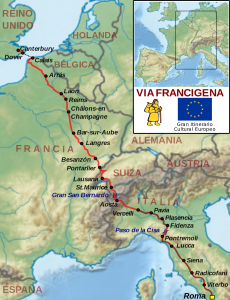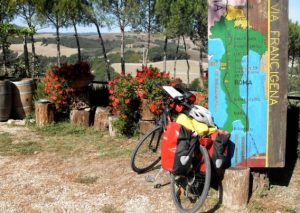The via Francigena, a journey not only spiritual: from England to Italy for an experience that will change your life
A unique journey, to put among the things to do in this 2018
"From Canterbury Cathedral until the English countryside and at cliffs of Dover. Over the English channel the way goes into gentle landscape of Picardy and Champagne. From England to the Via Francigena in Switzerland, from Sainte-Croix in Vuiteboeuf, then follow the Placida Venoge until Lac Léman. From Lausanne, the route winds through the Lavaux vineyards up to the bend of the Rhône. The ancient town of Octodurus up to the northern slopes of the great St Bernard pass.
The climb the Alps is gentle and gradual: dthe colle del Gran San Bernardo the descent is fast, and you are a few days in large spaces of Po Valley. The walk continues along thethe Po embankment. From Fidenza will begin the long climb that leads to pass the Apennines, among the forests of the Cisa pass. Includes memorable landscapes step by step, following the mountain Mule, the white roads and rows of cypress trees, the Cassia romana, polished stones from step, now towards Viterbo, surrounded by medieval walls.
You will be surprised by the strength of your steps, that slowly and Constance have in all, meter by meter, just over a thousand kilometers, in a month and a half's walk: the Via Francigena is an unforgettable experience. Is the voyage of life ".
Not only the famous Camino de Santiago in Italy, starting from England millions of pilgrims every year across Europe to come to Rome along the Via Francigena.
A journey that probably will change your life, a journey that you can start from the stage that you prefer, You can walk, by bike, alone or in company. A journey to discover new territories but also to look within and find new ones at the end of this adventure. Us in our trip we will follow step by step the same journey started many years ago by pilgrims. The Via Francigena, Franchigena, Francisca or Romea, is part of a bundle of routes, also called Roman pilgrimage routes, they led in the past by & #8217; Western Europe, in particular by France, in Rome.

The pilgrimage to Rome, on a visit to the tomb of the Apostle Peter, It was in the middle ages one of the three peregrinationes maiores along with the Holy Land and to Santiago de Compostela. Was the Pilgrim Sigeric who in 990 He left lascinaodci then the list of 79 stages that make the journey. The most significant testimonies Sigeric document represents one of this European network of roads in the middle ages, but it does not exhaust the many alternatives that came to define a dense Web of connections that the Pilgrim traveled around depending on the season, the political situation of geography, of religious beliefs related to the relics of the Saints. Starting from 1994 the Via Francigena was declared “Cultural route by the Council d & #8217; Europe”, assuming, like the Camino de Santiago, a supranational dignity.

The first leg of the journey is in England and part specifically from one of the world's most famous cathedrals, that of Canterbury. Next to the South portico of the Cathedral there is the rock indicating zero kilometer itinerary: It is from here that in 990 the Pilgrim Sigeric departed. From there it goes to the door Christchurch, and then theAbbey of Sant & #8217; Augustine along the Pilgrim's Way, where to 10 years Sigeric was Abbot. Abandoning the city moving on the North Downs Way, the hiking route that coincides with the Francigena route in Green English countryside. Kent has been called "garden of England", for its gardens and for beauty of rural landscape. The first stage ends at the sea at Dover with a stop at Shepherdswell typical English village.

